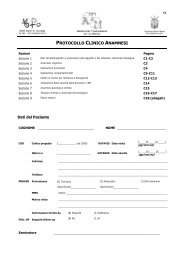Giovanni B Frisoni CURRICULUM VITAE - centro alzheimer
Giovanni B Frisoni CURRICULUM VITAE - centro alzheimer
Giovanni B Frisoni CURRICULUM VITAE - centro alzheimer
You also want an ePaper? Increase the reach of your titles
YUMPU automatically turns print PDFs into web optimized ePapers that Google loves.
“Google for brain imaging”, where neuroscientists worldwide will be able to find the world’s largest<br />
image databases on Alzheimer’s, algorithm tools to extract diagnostic and progression tracking<br />
markers, and adequate computational resources.<br />
This vision has been further strengthened with the IMI PHARMACOG – Prediction of Cognitive<br />
Properties of New Drug Candidates for NeuroDegenerative Diseases in Early Clinical Development<br />
project. This is a € 22M study where I am leading the largest workpackage (€ M 4.5) on the<br />
development of markers for disease modifying drugs in humans, representing the final success of<br />
developing a large ADNI‐based study in Europe (European ADNI). The image data that will be collected<br />
in the context of the PHARMACOG‐European ADNI initiative will contribute to further expand the base<br />
of data that neuGRID (and what will come after neuGRID) can accommodate and process.<br />
In this period, I have carefully kept thriving my traditional line of research on Alzheimer’s and cognitive<br />
disturbances. I have been the first Italian to publish on amyloid imaging (#P188 in Neurology), the only<br />
with a say in major journals (#E7) despite amyloid imaging has not yet landed in Italy, the first to show<br />
evidence of validity of the new revised criteria for the diagnosis of Alzheimer’s disease worldwide<br />
(#P197), and, to the best of my knowledge, the first to test the new revised criteria in a clinical service<br />
(the “Translational Outpatient Memory Clinic” at the IRCCS‐FBF) (#P197). I have given further fuel to my<br />
translational approach to the early diagnosis of Alzheimer’s with the launch of an international effort<br />
aimed at developing standardized operational procedures for the measurement of hippocampal<br />
atrophy (Harmonization of Protocols for the Manual Tracing of the Hippocampus Development and<br />
Validation of a Unified Standard Protocol: An EADC‐ADNI Joint Effort), whose vision is to turn<br />
hippocampal volumetry from a diagnostic procedure feasible in few highly specialized research setting<br />
into a routinely applicable diagnosic exam.<br />
With the appointment as Head of the Psychogeriatric Ward in 2005, I have opened a new line of<br />
research on psychiatric diseases. The clinical population of the ward is made of scientifically dejected<br />
patients, i.e. psychiatric patients (mainly schizophrenics) over 65 years of age, with decades of the most<br />
diverse pharma and non‐pharma treatments. By applying the analytical tools successfully used in<br />
patients with neurodegenerative disorders, I have been able to describe their brain structural features<br />
in a paper published in Biological Psychiatry (#P189), and more manuscripts are currently in<br />
preparation. Moreover, thanks to the use of a creative approach to study hundreds of healthy persons<br />
with MR imaging, my research group has described the structural features of a normal personality trait,<br />
i.e. alexithymia (#P167).<br />
8. CLINICAL<br />
Clinical positions<br />
2005‐2010: Head of the Psychogeriatric Ward at the IRCCS (Istituto di Ricovero e Cura a Carattere<br />
Scientifico – Scientific Institute of Research and Care) Fatebenefratelli Hospital, Brescia – FBF, a long‐<br />
term 40‐bed ward devoted to elderly psychiatric patients with behavioral disturbances. The medical<br />
staff is made of trained and specialized physicians (2 psychiatrists and one geriatrician).<br />
2000‐2004: temporary interruption of clinical duties following a request from the Scientific<br />
Direction of the IRCCS‐FBF to devote up to 85% of my time to research, aiming to foster domestic<br />
scientific productivity. In this period, I have continued seeing outpatients 2 half days per week.<br />
6




